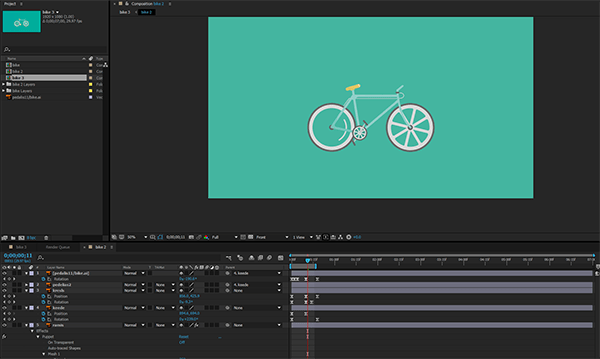

- #WHAT VIDEO FORMAT IS BEST FOR ADOBE AFTER EFFECTS MOVIE#
- #WHAT VIDEO FORMAT IS BEST FOR ADOBE AFTER EFFECTS PDF#
- #WHAT VIDEO FORMAT IS BEST FOR ADOBE AFTER EFFECTS MP4#
- #WHAT VIDEO FORMAT IS BEST FOR ADOBE AFTER EFFECTS PRO#
- #WHAT VIDEO FORMAT IS BEST FOR ADOBE AFTER EFFECTS SOFTWARE#
#WHAT VIDEO FORMAT IS BEST FOR ADOBE AFTER EFFECTS MOVIE#
I used the Adobe Media Encoder 5.5 to convert an old QuickTime movie file that I had to an MP4. I wanted a file I could output to interactive PDF, to a SWF file, and to an EPUB file. I started creating a test file in InDesign CS5.5.
#WHAT VIDEO FORMAT IS BEST FOR ADOBE AFTER EFFECTS MP4#
For video files, use a format that is compatible with Apple iTunes, such as an MP4 file with h.264 encoding.” According to the User Guide, “Supported video and audio files you place in InDesign play when tapped in the Viewer. H.264 can also be used on the iPad and other tablets for video in publications created by the Adobe Digital Publishing Suite. m4v, the latter is specifically for Apple and works in both iPad and iPhone.” (In addition to her original eBook, she has also has available on her website a small eBook about creating files with video and audio for playing on iOS devices and the Nook.) As shown below, I found that MP4 seemed to work just fine. While there is not much difference between. She found that the format which worked the best is “H.264 video compression, AAC compressed audio, all contained in an MPEG4 container, with a. Liz Castro, author of EPUB: Straight to the Point, did some testing of different formats on Apple’s iOS devices. It is not part of the EPUB 2 specification, but with the recent development of EPUB 3 (now a proposed specification), properly created video can now be viewed in Apple’s iBooks application on iPad and iPhone, and on the Barnes & Noble Nook.

#WHAT VIDEO FORMAT IS BEST FOR ADOBE AFTER EFFECTS PDF#
Probably any of the flavors of H.264 listed above would work in an interactive PDF or SWF file created by InDesign (I didn’t have time to extensively test each flavor).īut video is now becoming available for EPUB files as well. And that’s why it will work on devices like the iPad which don’t support “Flash files.” But while H.264 is supported in Flash, it’s not at all exclusive to the Flash player. He compared them to the older “legacy media” which required external players like QuickTime. James Fritz covered the transition of Adobe InDesign CS5 to what he called “Flash media” in a posting in August 2010.
#WHAT VIDEO FORMAT IS BEST FOR ADOBE AFTER EFFECTS PRO#
You can create a file in H.264 format either by using the Adobe Media Encoder 5 or 5.5 (included with Adobe Creative Suite 5 or 5.5), with QuickTime 7 Pro or QuickTime X on the Macintosh, and other products that can encode video files. What’s confusing is that the standard can appear as several different file extensions?MP4, F4V, MOV, and M4V are some of the most common. There is certainly no bias between Windows and Mac in fact H.264 is so popular precisely because the videos don’t care what platforms they run on. This ensures the highest possible levels of security, and a guaranteed user experience when viewing PDFs with the Adobe Acrobat Family. Even if you have the standalone Flash Player installed on your computer, it will not be used.
#WHAT VIDEO FORMAT IS BEST FOR ADOBE AFTER EFFECTS SOFTWARE#
It does not use any external software whatsoever, and will play back identically on Windows and Mac. The resulting object is called a Rich Media Annotation (RMA), and plays using the embedded copy of Flash Player when viewed in Adobe Reader 9+ or Acrobat 9+. If you embed a video file into a PDF page using Acrobat X Pro, the only formats it will permit are Flash or H.264. When you view videos on YouTube, Vimeo, or other sources on the internet, you’re viewing H.264.Īcrobat guru Dave Merchant pointed out some advantages of the format in a PDF file: Apple has supported the format on its very popular devices (iPad, iPhone and iPod Touch), and it’s equally viewable on Macintosh or Windows computers.

They are supported in Adobe Flash Player, and they are embedded into Acrobat 9 and X, and Reader 9 and X. H.264 files are the most widely supported: Adobe InDesign CS 5 and 5.5 let you place them, and you can control their viewing with the Media panel. What is the best video format to use for most digital publishing output? Surprisingly, there is usually one answer?H.264 files. All of these formats support, to varying degrees, the inclusion of video files as part of the output. You can create an EPUB file to view in a eBook reader, and you can create a version for tablets with the Adobe Digital Publishing Suite. You can export an InDesign publication to interactive PDF, or to a SWF file to view in your browser. Recent versions of InDesign have made it the hub application for digital publishing.


 0 kommentar(er)
0 kommentar(er)
